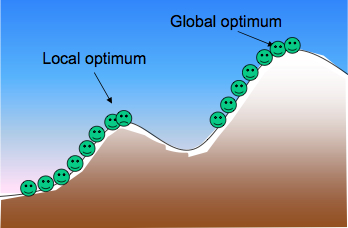My friend Vinay Gupta has come up with the idea to start the Big Picture Days series with an event on what he calls swarm cooperatives, meaning instant campaigns, unconferences, hackathons and other unorthodox constellations of people in action that are both collaborative and non-hierarchical. He got in touch and asked me to give a talk about it in the context of public policy. That sounds crazy, but it got me thinking. For years now I have been involved in policy initiatives that incorporate an element of that openness, of that fluidity. Can we really speak of policy making for swarms? If so, what does that mean?
At the heart of this concept lies a fundamental paradox. Swarms derive their uncanny efficiency from radical decentralization of decision making and action; yet, decentralization might (and does) cause the swarm to lose coherence, and its action to lose directionality. That does not work well with public policy, that requires agency: no agency, no policy. The main tool I use to debunk this paradox is network theory: I think about swarms as people in networks. In networks, nodes might be equal in the amount of top-down power over others, but they will typically be very unequal in terms of connectivity, hence the ability to spread information (including narratives and calls to action) across the network. Uneven connectivity adds some directionality to the swarm, in the sense that the most connected people get it to go their way most of the times.
Public policy is generally understood as a top-down process: some leader somewhere makes a decision and that decision is enacted. I call this the linear model. Since it misses all of the feedbacks and adaptation, the linear model does not work if the context of your policy is a complex adaptive system: the system simply changes its shape to route around the policy, or even push it back (more details). Not only do its recipes not deliver: they might cause serious harm. This provides a good case for trying to apply swarm thinking to government.
It can be frightfully difficult, because the linear model is encoded into law and hardwired into organizational charts, remits and procedures: but the potential rewards are immense. Why? Because if you want to build a swarm, you need people to want to join it. By definition, these people can’t be your employees, or anyone you have command and control over; they have to be free agents that want to cooperate. Now, there are already very many opportunities to collaborate out there, and few of them have attracted the lion’s share of available “swarming” (think Wikipedia, with tens of millions of participants). This means that people will cherrypick, and you will have to work extra hard to win them over. Swarm building is a buyers’ market. That’s a big reality check for your project right there.
The first consequence of all this: the swarm-builder’s payoff to bullshit immediately becomes negative. Well-packaged bullshit might fill a report or a PowerPoint presentation that gets past your boss, but has no chance of whipping up enthusiasm in a bunch of strangers that are not taking your money. I believe this has given some competitive edge to my own projects. Cutting corners would not do it: I had to work at full steam, or call it quits.
Vinay’s invitation gave me the opportunity to lay out tips and tricks to policy making for swarms. I ended up with a weird list, with items like Falkvinge’s Law, randomness (my favorite), timebombs, the fishing rod model, dogfood and parties. It is tentative and incomplete, but does represent the very frontier of my thinking (and my practice!) of public policy. If you are interested in this kind of stuff, you might like my slides. I added my notes, so you get a reasonable rendition of my 10-minute talk at Big Picture Days.

